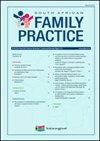Sociodemographics, behaviour and knowledge of first South African HPV-vaccine recipients
IF 1.2
Q2 MEDICINE, GENERAL & INTERNAL
引用次数: 0
Abstract
Background: Infection with the human papillomavirus (HPV) is a necessary cause of cervical cancer and is one of the most prevalent sexually transmitted infections worldwide. Primary prevention strategies target reducing HPV acquisition through vaccination, limiting exposure (e.g. delayed sexual debut, barrier contraception) and health education focusing on sexual behaviour and tobacco use.Methods: The ImmunoVACCS study, conducted from 2019 to 2022 in two provinces in South Africa, examined sociodemographic characteristics, sexual practices, and knowledge of cervical cancer and the HPV vaccine among young female vaccine recipients. It encompassed participants from the previously conducted vaccine implementation trials, VACCS 1 and VACCS 2 (2011–2014). Recruitment involved telephonic contact with eligible potential participants. Data were collected through self-administered questionnaires.Results: One hundred and eleven participants took part in the current study (median age: 20 years; age range: 16–22 years). Most sexually active participants had their first engagement in secondary school (96.2%), and 77.2% used contraception during their last sexual activity. Knowledge gaps were evident, with only 13.5% recognising cervical cancer’s cervix origin and 3.6% attributing it to a virus. Despite this, 70.3% had heard of a vaccine for cervical cancer. Less than half knew about the importance of regular Pap smears (49.5%), vaccine protection (44.1%) or condom use (20.7%) against HPV and cervical cancer.Conclusion: The current study demonstrates that young women still lack complete information on cervical cancer and its risk factors even after receiving health education linked with vaccination.Contribution: This study underscores the necessity of ongoing education about HPV, its risks and preventive measures among young women to combat cervical cancer.南非首批接种人乳头瘤病毒疫苗者的社会人口、行为和知识情况
背景:人乳头瘤病毒(HPV)感染是宫颈癌的一个必要病因,也是全球最普遍的性传播感染之一。一级预防策略的目标是通过接种疫苗、限制暴露(如推迟初次性行为、屏障避孕)以及以性行为和烟草使用为重点的健康教育来减少HPV感染:ImmunoVACCS研究于2019年至2022年在南非的两个省份进行,调查了社会人口特征、性行为以及年轻女性疫苗接种者对宫颈癌和HPV疫苗的了解情况。该研究涵盖了之前开展的疫苗实施试验 VACCS 1 和 VACCS 2(2011-2014 年)的参与者。招募工作通过电话联系符合条件的潜在参与者。数据通过自填问卷收集:111名参与者参加了本次研究(年龄中位数:20岁;年龄范围:16-22岁)。大多数性行为活跃的参与者(96.2%)的首次性行为发生在中学时期,77.2%的参与者在最近一次性行为中采取了避孕措施。知识差距很明显,只有 13.5%的人认识到宫颈癌起源于宫颈,3.6%的人将其归咎于病毒。尽管如此,70.3% 的人听说过宫颈癌疫苗。只有不到一半的人知道定期进行子宫颈抹片检查(49.5%)、接种疫苗(44.1%)或使用安全套(20.7%)对预防人乳头瘤病毒和宫颈癌的重要性:本研究表明,即使在接受了与疫苗接种相关的健康教育后,年轻女性仍然缺乏有关宫颈癌及其风险因素的完整信息:本研究强调了在年轻女性中持续开展有关人乳头瘤病毒、其风险和预防措施的教育以防治宫颈癌的必要性。
本文章由计算机程序翻译,如有差异,请以英文原文为准。
求助全文
约1分钟内获得全文
求助全文
来源期刊

South African Family Practice
MEDICINE, GENERAL & INTERNAL-
CiteScore
1.50
自引率
20.00%
发文量
79
审稿时长
25 weeks
期刊介绍:
South African Family Practice (SAFP) is a peer-reviewed scientific journal, which strives to provide primary care physicians and researchers with a broad range of scholarly work in the disciplines of Family Medicine, Primary Health Care, Rural Medicine, District Health and other related fields. SAFP publishes original research, clinical reviews, and pertinent commentary that advance the knowledge base of these disciplines. The content of SAFP is designed to reflect and support further development of the broad basis of these disciplines through original research and critical review of evidence in important clinical areas; as well as to provide practitioners with continuing professional development material.
 求助内容:
求助内容: 应助结果提醒方式:
应助结果提醒方式:


